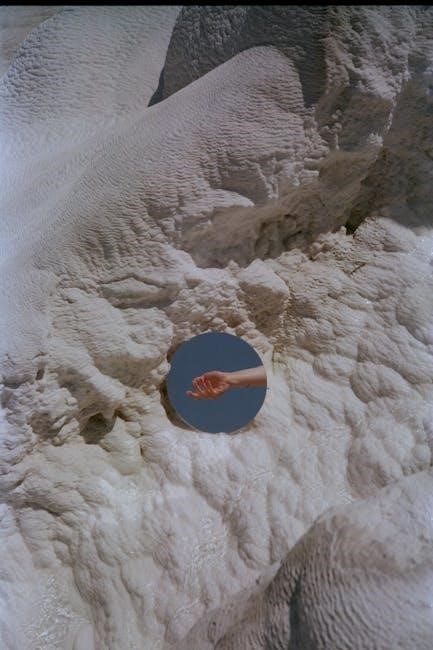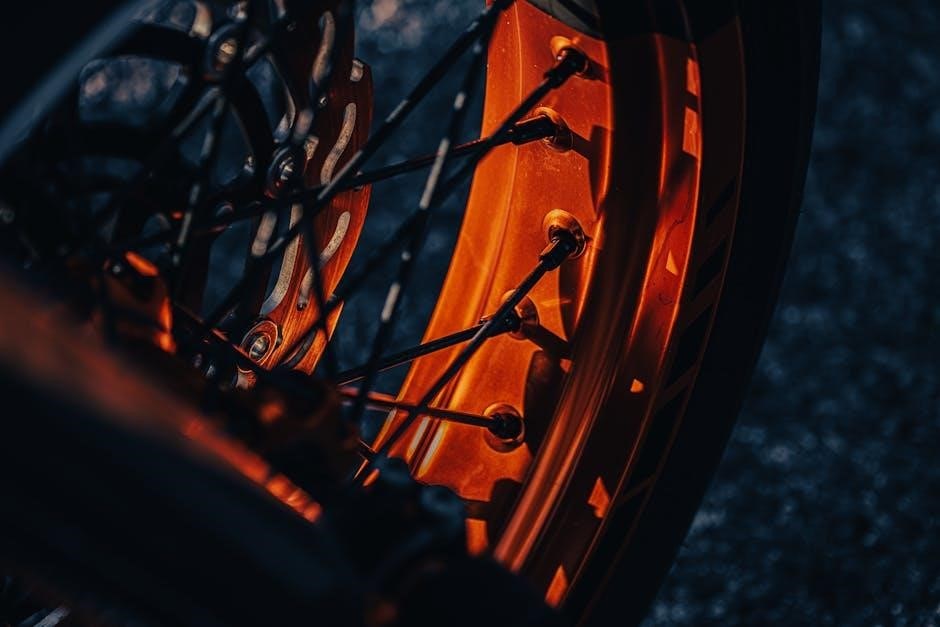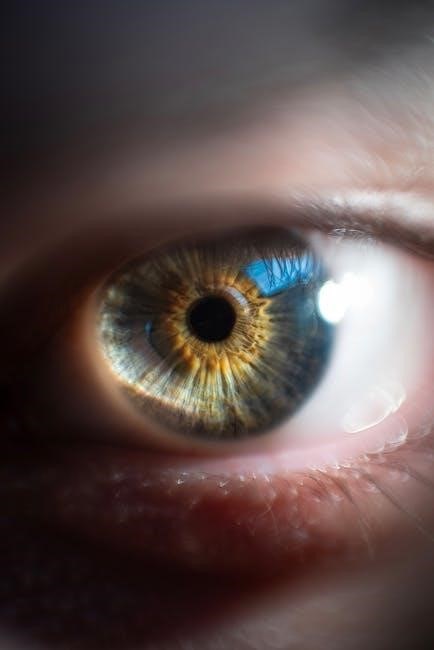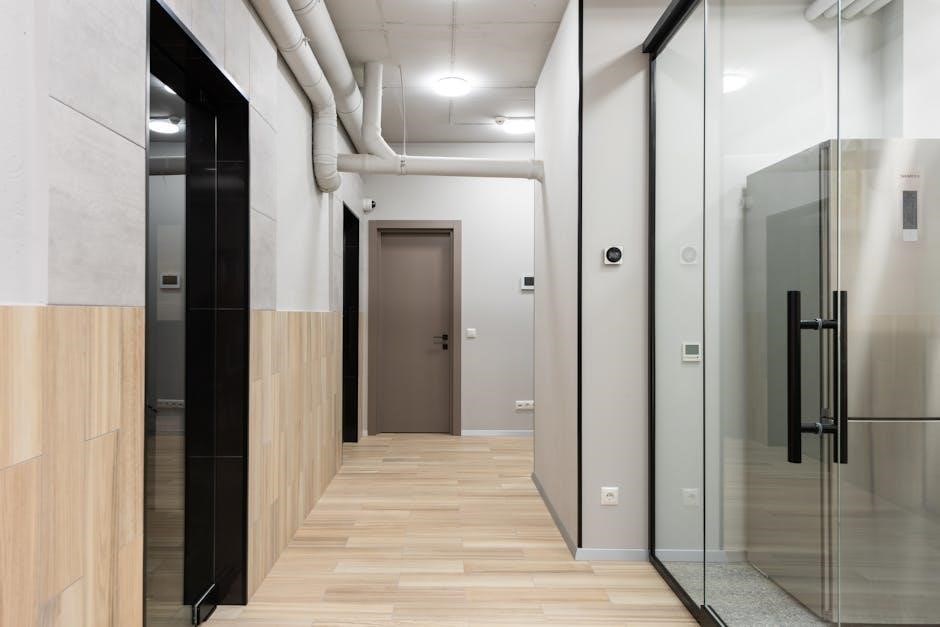compound light microscope parts and functions worksheet pdf
Summary
Download the ultimate guide to understanding your compound light microscope! Get detailed parts and functions in this easy-to-follow worksheet PDF.

The compound light microscope is a fundamental scientific tool used to magnify small specimens․ It consists of two main lenses: the eyepiece and objective lenses, which work together to enlarge images․ Understanding its parts and functions is essential for proper usage and interpretation of results․ This microscope is widely used in biology, medicine, and education for detailed specimen observation․
1․1 Overview of the Compound Light Microscope
The compound light microscope is an optical instrument that uses lenses to magnify specimens․ It consists of key components like the eyepiece, objective lenses, and stage․ Its primary function is to enlarge small objects, making them visible for detailed observation․ Widely used in biology and medicine, it is an essential tool for studying microscopic structures and understanding cellular details․ Proper understanding of its parts enhances its functionality in educational and research settings․
1․2 Importance of Understanding Microscope Parts and Functions
Understanding the parts and functions of a compound light microscope is crucial for effective use and maintenance․ Proper knowledge ensures accurate specimen observation, prevents damage to the instrument, and enhances safety․ Familiarity with components like the diaphragm, focus knobs, and objective lenses allows for precise adjustments, improving image clarity․ This understanding also aids in troubleshooting and mastering advanced microscopy techniques, making it a foundational skill in scientific education and research․
Main Parts of the Compound Light Microscope
The compound light microscope consists of key components such as the eyepiece, objective lenses, revolving nosepiece, body tube, arm, stage, and stage clips, each serving distinct roles in specimen observation and focus․
2․1 Eyepiece
The eyepiece, also known as the ocular lens, is a crucial part of the compound microscope․ It contains a magnification lens, typically with a 10X power, which enlarges the image produced by the objective lens․ The eyepiece works in conjunction with the objective lens to provide a total magnification of the specimen․ Proper use of the eyepiece ensures clear observation of the specimen under study, making it essential for accurate microscopy․
2․2 Objective Lenses
The objective lenses are located near the specimen and play a key role in magnifying it․ They are available in different magnification powers, such as 4X, 10X, 40X, and 100X․ The objective lens collects light from the specimen and forms an enlarged image․ This image is then magnified further by the eyepiece․ The objective lens is crucial for resolving fine details in the specimen, making it essential for detailed microscopic observations․ Proper selection of the objective lens ensures optimal viewing results․
2․3 Revolving Nosepiece
The revolving nosepiece is a circular platform that holds multiple objective lenses․ It allows easy rotation to switch between different lenses without disturbing the specimen․ This feature enhances flexibility during observation, enabling quick changes in magnification power․ The nosepiece ensures smooth transition between objectives, maintaining focus and alignment․ It is a critical component for efficient and precise microscopy, especially when examining specimens at varying scales․ Proper alignment of the nosepiece is essential for clear imaging․
2․4 Body Tube
The body tube connects the eyepiece to the objective lenses, housing the internal optical components․ It maintains the correct distance between the lenses for proper magnification․ The body tube supports the microscope’s structural integrity and alignment․ Proper handling is essential to avoid misalignment, ensuring clear and accurate observations․ Regular cleaning and maintenance of the body tube are crucial for optimal performance and longevity of the microscope․ This part is vital for precise imaging․
2․5 Arm
The arm is a sturdy structural component that connects the body tube to the stage․ It provides stability and balance, ensuring smooth operation․ Proper handling of the arm is essential for maintaining the microscope’s alignment and preventing damage․ Regular care ensures longevity and optimal performance․
2․6 Stage
The stage is a flat platform where the specimen slide is placed for observation․ It is typically equipped with clips to secure the slide in position, ensuring stability during viewing․ The stage is crucial for precise specimen alignment under the objective lens, allowing for accurate focus and clear visualization of the sample․ Proper use of the stage is essential for effective microscopy․
2․7 Stage Clips
Stage clips are metal or plastic holders attached to the microscope stage․ They securely grip the edges of the specimen slide, keeping it firmly in place during observation․ This prevents movement and ensures the sample remains centered under the objective lens, allowing for clear and stable viewing․ Properly using the stage clips is essential for maintaining focus and avoiding damage to the microscope or slide․

Functional Parts of the Compound Light Microscope
The functional parts of a compound light microscope include the coarse and fine adjustment knobs, light source, diaphragm, and focus knobs․ These components work together to focus and illuminate specimens for clear observation, ensuring precise control over the imaging process․
3․1 Coarse Adjustment Knob
The coarse adjustment knob is used to focus the specimen by moving the stage up or down rapidly․ It is typically located on the side of the microscope and is used for initial focusing․ This knob should be used carefully to avoid damaging the slide or objective lens․ It is most effective when used in conjunction with the fine adjustment knob for precise focus․
3․2 Fine Adjustment Knob
The fine adjustment knob provides precise control over the focus of the specimen․ It is used after the coarse adjustment knob to make smaller, more accurate adjustments․ This knob ensures a sharp, clear image by moving the stage in minimal increments․ Proper use of the fine adjustment knob is crucial for achieving optimal focus without damaging the microscope or the specimen․
3․3 Light Source
The light source is a crucial component of the compound microscope, providing the necessary illumination for observing specimens․ It ensures that the specimen is visible under magnification, allowing for detailed examination․ In many microscopes, the light source is built-in, such as an LED or halogen bulb․ Alternatively, some models use a mirror to reflect light from an external source, offering flexibility in various laboratory settings․ Proper alignment and adjustment of the light source are essential for optimal viewing․
3․4 Diaphragm
The diaphragm is a key functional part of the compound light microscope, regulating the amount of light that reaches the specimen; Located beneath the stage, it contains apertures of varying sizes that can be adjusted to control light intensity․ By altering the diaphragm’s opening, users can optimize illumination for different specimens, enhancing image clarity and reducing glare․ Proper use of the diaphragm is essential for achieving clear and detailed observations under the microscope․
3․5 Focus Knobs
The focus knobs are essential for adjusting the microscope’s focus to achieve clear images․ They include coarse and fine adjustment knobs․ The coarse knob makes large focus adjustments, while the fine knob provides precise adjustments․ Proper use of these knobs ensures sharp, detailed observations․ They work in conjunction with the diaphragm and objective lenses to optimize specimen visibility․ Correct focusing is vital for accurate microscopic examinations and maintaining the integrity of the specimen under study․
How to Use the Compound Light Microscope
Using a compound light microscope involves preparing the instrument, focusing the specimen, and adjusting light intensity․ Proper techniques ensure clear observations and specimen preservation․
4․1 Preparing the Microscope for Use
Preparing the microscope involves ensuring all parts are clean and properly aligned․ Start by cleaning the lenses and stage with soft cloth to avoid contamination․ Adjust the light source for optimal illumination and place the specimen on the stage, securing it with stage clips․ Finally, check the focus knobs and ensure the microscope is stable for observation․
4․2 Focusing the Specimen
To focus the specimen, start by adjusting the coarse adjustment knob to bring the sample into approximate focus under low magnification․ Once the image is near focus, switch to the fine adjustment knob for precise clarity․ Ensure the light source is properly aligned and the diaphragm is open to allow sufficient illumination․ This step is crucial for achieving clear and detailed observations․
4․3 Adjusting the Light Intensity
To optimize illumination, adjust the diaphragm to regulate light entering the stage․ Open or close it to balance brightness without overexposing the specimen․ Ensure the light source is properly aligned and adjust its intensity if necessary․ Proper lighting enhances clarity and prevents glare, making it easier to observe specimens effectively under the compound light microscope․

Calculating Magnification
Magnification is calculated by multiplying the eyepiece power (typically 10x) by the objective lens power (e․g․, 40x or 100x)․ This gives the total magnification power, helping to understand the scale of the observed specimen․
5․1 Understanding Magnification Power
Magnification power refers to the ability of the microscope to enlarge specimens․ The eyepiece typically has a 10x power, while objective lenses vary (e;g․, 40x, 100x)․ Understanding this concept helps in interpreting the scale of observed samples, enabling precise observations in scientific studies․ Proper knowledge of magnification power is crucial for accurately analyzing microscopic structures and their details, ensuring clear and effective visualization․
5․2 Formula for Total Magnification
The total magnification of a compound light microscope is calculated by multiplying the magnification power of the eyepiece by the magnification power of the objective lens․ The formula is: Total Magnification = Eyepiece Magnification × Objective Lens Magnification․ For example, a 10x eyepiece paired with a 40x objective lens results in 400x total magnification․ This calculation is essential for determining the scale of observed specimens during microscopy․

Diagrams and Labeling
Diagrams are essential for understanding microscope parts․ Labeled illustrations help identify components like eyepieces, objectives, and stages, enhancing learning and proper usage of the instrument․
6․1 Labeled Diagram of the Compound Light Microscope
A labeled diagram of the compound light microscope illustrates its key components, such as the eyepiece, objective lenses, revolving nosepiece, body tube, arm, stage, and stage clips․ Each part is clearly marked and described, providing a visual guide for understanding the microscope’s structure and functionality․ This diagram is essential for educational purposes, helping students and researchers identify and familiarize themselves with the instrument’s design and operation․
6․2 Matching Parts with Their Functions
Matching parts with their functions helps users understand the microscope’s operation․ The eyepiece magnifies images, while objective lenses focus light on the specimen․ The stage holds the slide, and stage clips secure it․ The coarse and fine adjustment knobs focus the image, and the diaphragm regulates light intensity․ This activity enhances familiarity with the microscope’s components and their roles in achieving clear observations․ It is a key educational tool for beginners․

Advantages and Limitations
The compound light microscope offers high magnification and cost-effectiveness, making it ideal for educational and research settings․ However, it has limitations like limited resolution and the need for prepared specimens․ Its simplicity and versatility balance these drawbacks, ensuring its widespread use in various scientific applications․ Proper maintenance can extend its functionality and performance over time․
7․1 Advantages of the Compound Light Microscope
The compound light microscope offers several advantages, including high magnification capabilities, cost-effectiveness, and ease of use․ It is widely used in educational settings due to its simplicity and durability․ The microscope provides clear images of specimens, making it an essential tool in biology and medicine․ Its portability and relatively low maintenance further enhance its practicality for various applications․ These features make it a versatile instrument for detailed specimen observation and analysis․
7․2 Limitations of the Compound Light Microscope
The compound light microscope has limitations, including a maximum magnification of 1000x due to resolution constraints․ It cannot observe living cells over extended periods without causing damage․ Additionally, it requires prepared slides, limiting real-time observations․ The microscope also struggles with thick or opaque specimens and has a shallow depth of field, making it less effective for certain types of samples․ These limitations highlight the need for alternative microscopes in advanced studies․

Safety Tips and Best Practices
Always handle the microscope with care to avoid damage․ Never force any parts to move, as this can break the instrument․ Ensure the light source is used correctly and safely․ Regular cleaning and proper storage are essential for maintaining functionality․ Follow all safety guidelines to ensure optimal performance and longevity․
8․1 Handling the Microscope Safely
Always handle the microscope with care to prevent damage․ Use both hands when carrying it, supporting the base and arm․ Avoid touching the lenses or forcing any moving parts․ Keep the microscope on a stable, flat surface and ensure it is securely positioned․ Regularly clean the microscope with appropriate materials, and store it in a dry, protected area when not in use․ Proper handling ensures longevity and maintains its functionality for accurate observations․
8․2 Avoiding Common Mistakes
Common mistakes when using a compound microscope include over-tightening the focus knobs, which can damage the stage or objective lenses․ Never force parts to move, as this can break delicate components․ Ensure the slide is properly secured to avoid movement during observation․ Also, avoid touching the lenses to prevent smudging․ Always use the correct light intensity to preserve specimen integrity and maintain clear visibility․ Proper techniques prevent errors and ensure accurate results․

Troubleshooting Common Issues
Common issues with the compound light microscope include blurry vision and insufficient light․ Ensure the light source is properly adjusted and the diaphragm is clean․ Always check that the slide is correctly positioned and that the focus knobs are used appropriately․ Regular maintenance and proper handling can prevent these problems․
9․1 Blurry Vision and Focus Problems
Blurry vision in a compound light microscope is often due to improper focusing or dirty lenses․ Always ensure the eyepiece and objective lenses are clean and free of debris․ If the image remains unclear, check the focus knobs for correct adjustment․ Adjust the coarse and fine adjustment knobs slowly and carefully to achieve sharp focus․ Proper slide preparation and light intensity are also crucial for clear visibility․
9․2 Insufficient Light
Insufficient light can hinder visibility under the microscope․ Ensure the light source is turned on and adjusted properly․ Check the diaphragm to confirm it is open to allow adequate light․ Clean the lenses and mirror if they are dirty, as dirt can block light․ Also, ensure the slide is correctly positioned under the objective lens for optimal illumination․

Comparison with Other Microscopes
The compound light microscope differs from the stereo microscope in its ability to provide highly detailed, inverted images․ Unlike the electron microscope, it uses visible light, making it more accessible for educational and routine observations․
10․1 Stereo Microscope vs․ Compound Microscope
The stereo microscope provides a 3D view of larger objects, while the compound microscope offers higher magnification for smaller specimens․ Stereo microscopes are used for observing surface details, whereas compound microscopes are ideal for detailed cellular studies․ Both use light but differ in application, with the compound microscope being more common in educational and laboratory settings for biological samples․
10․2 Electron Microscope vs․ Compound Microscope
The electron microscope uses electrons, offering higher resolution, while the compound light microscope uses visible light․ Electron microscopes are suited for nanoscale structures, whereas compound microscopes are ideal for biological specimens․ Both are essential tools but differ in technology and application, with the compound microscope being more accessible for everyday laboratory and educational use․

Interactive Learning Activities
Engage with worksheets and quizzes to identify microscope parts and functions․ Interactive labeling exercises and virtual simulations enhance understanding and retention of compound microscope concepts․
11․1 Worksheets for Identifying Parts
Worksheets are essential tools for learning microscope components․ They include labeling exercises, matching games, and short-answer questions to test knowledge of parts like eyepieces, objectives, and stages․ These resources help users recognize and understand the functions of each part, enhancing familiarity with the microscope’s structure․ They also provide a hands-on approach to learning, making complex concepts more accessible for students and researchers․
11․2 Quizzes on Functions and Operations
Quizzes are an effective way to assess understanding of microscope functions and operations․ They cover topics like magnification calculations, focusing techniques, and proper handling of parts․ Multiple-choice, true/false, and fill-in-the-blank formats test knowledge retention․ Quizzes also identify gaps in understanding, ensuring users can operate the microscope confidently and accurately․ Regular testing reinforces learning and prepares users for practical applications in labs and research settings․

Maintenance and Care
Regular cleaning with specialized solutions and soft cloths prevents damage․ Store the microscope in a dry, cool place to avoid mold․ Avoid harsh chemicals and ensure all parts are secure before storage to maintain functionality and longevity․
12․1 Cleaning the Microscope
Regularly clean the microscope using distilled water and specialized cleaning solutions․ Use soft, lint-free cloths to wipe lenses and surfaces․ Avoid harsh chemicals, which can damage coatings․ Clean the stage and stage clips gently to prevent scratches․ Always store the microscope in a dry, cool place to prevent mold growth and ensure optimal performance․
12․2 Storing the Microscope Properly
Store the microscope in a cool, dry place to prevent moisture damage․ Use a protective cover to shield it from dust․ Avoid exposure to direct sunlight, as UV rays can harm optical components․ Ensure the microscope is placed on a stable surface and secure during transport․ Store accessories like slides and lens tissues separately to maintain organization and prevent damage․
13․1 Summary of Key Points
The compound light microscope is a vital tool in biology and medicine for observing microscopic specimens․ Its key parts include the eyepiece, objective lenses, stage, and focus knobs, each serving distinct roles․ Proper use involves adjusting light intensity and focusing for clarity․ Understanding these components enhances scientific exploration and education․ Regular maintenance ensures longevity and optimal performance, making it an indispensable instrument in various fields․
13․2 Encouragement for Further Study
Exploring the compound light microscope opens doors to fascinating scientific discoveries․ By mastering its parts and functions, students can deepen their understanding of biology, chemistry, and medicine․ Encourage further learning through hands-on experiments and advanced microscopy techniques․ This foundational knowledge inspires curiosity and prepares individuals for careers in research and healthcare, where microscopes play a pivotal role in innovation and problem-solving․